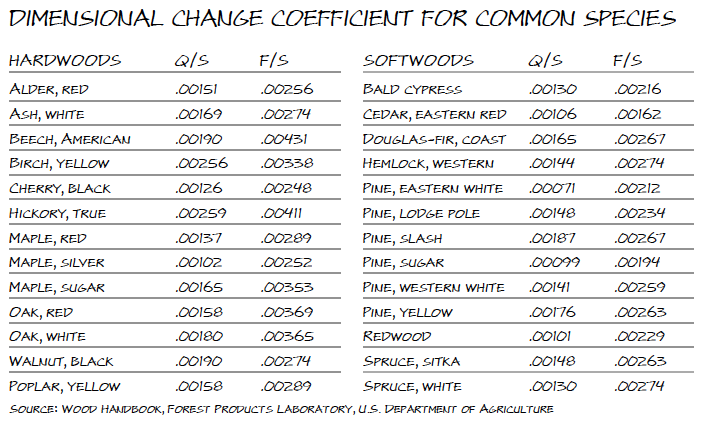Calculating Wood Shrinkage and Expansion
You’ve spent great time in picking out the right wood, hours laying out each piece and measuring twice to make 1 perfect cut. It’s finally time to begin constructing your masterpiece. Everything is coming together beautifully. Then, shrinkage! Wood movement can ruin what would have been a beautiful and well-constructed project. So, how do you prevent it? There is a way to calculate wood shrinkage and expansion so that you can plan for it and make all your future projects come together perfectly.
To calculate wood shrinkage, all you need to know is the species of wood, Board width, average annual change in moisture, and type of lumber cut (flatsawn, quartersawn).
Measuring the board’s width
Keep in mind that wider boards expand and contract more than narrower ones. Wood expands and contracts the most across the width. You’ll want to measure the width in inches for this calculation.
Finding moisture change
The moisture in the air can cause quite a bit of expansion or shrinkage in the wood. Wet Air will expand the wood and dry air will shrink it. You can use a moisture meter to note the highest moisture content in your wet season and the lowest in your dry season. Simply subtract the smaller number from the larger number to get your annual change. Most climate controlled homes will change 3-4 percent in a year.
Check the dimensional change coefficient of the species (don’t worry, we have a chart for that)
The dimensional change coefficient reflects how much a specific species of wood will change in width. The chart works for wood that is between 6 percent and 14 percent moisture. First, you’ll need to know whether your wood is flatsawn or quartersawn. If it’s not entirely flatsawn or quartersawn, just use your best guess. You can typically tell which type of cut it is by looking at the end grain. Use the chart below to get the dimensional change coefficient for the wood species you are using.
Time to crunch some numbers
To get the projected shrinkage/expansion you’ll want to multiply board width (in inches) by the annual change in Moisture. Then multiply by the dimensional change coefficient number from the chart. Voila!
Shortcut
If you feel like letting someone else do the math for you, we have also found this handy wood shrinkage calculator on WoodWeb Forum. Click here for the Wood Shrinkage / Expansion Calculator.
Information for calculating wood shrinkage and expansion and Species Coefficient chart was taken from Popular Woodworking.
Tags: Wood expansion, wood shrinkage
One Response to “Calculating Wood Shrinkage and Expansion”
Leave a Reply






I note that there is a quite complete discussion in the Wood Handbook, Chapter 12 (http://www.conradlumberco.com/pdfs/ch12_Drying_Control_of_Moisture.pdf). This article includes equilibrium moisture content for a large range of US cities (per month), as well as several techniques for drying wood, as well as an even more complete table than here, if needed.
Also good article from Oklahoma State University (http://pods.dasnr.okstate.edu/docushare/dsweb/Get/Document-2535/NREM-5009web.pdf).
While most articles talk tangential and radial dimension changes, CP has translated that into quarter-sawn and flat-sawn. Not necessarily perfect, but easier to apply, and fully adequate given other uncertainties. Quarter sawn is radial, and properly flat sawn is tangential.
I note a slight ambiguity on moisture — is it percent (as in 3) or decimal (as in 0.03). The answer is percent (as in 3). Thus, if the moisture content change is, say, 12% to 8%, the dimensional change of the wood is
DeltaD = T(inches)*C(coefficient above)*(12-8).
Thanks to CP for a good blog here.